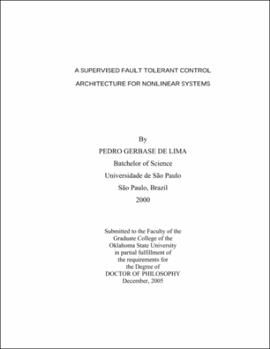| dc.contributor.advisor | Yen, Gary | |
| dc.contributor.author | de Lima, Pedro Gerbase | |
| dc.date.accessioned | 2013-12-10T18:05:47Z | |
| dc.date.available | 2013-12-10T18:05:47Z | |
| dc.date.issued | 2005-12 | |
| dc.identifier.uri | https://hdl.handle.net/11244/7853 | |
| dc.description.abstract | Scope: The growing complexity of physical plants and control missions inevitably leads to increasing occurrence, diversity and severity of faults. Availability, defined as the probability that a system or equipment will operate satisfactory and effectively at any point of time, becomes a factor of increasing importance. Fault Tolerant Control (FTC) is a field of research that aims to increase availability and reduce the risk of safety hazards and other undesirable consequences by specifically designing control algorithms capable of maintaining stability and/or performance despite the occurrence of faults. This report presents a novel FTC solution based on a hierarchical architecture in which an adaptive critic controller is overseen by a supervisor managing a dynamic model bank of fault solutions. | |
| dc.description.abstract | Findings and Conclusions: The presented work has demonstrated that the implementation of a synergistic combination of a reconfigurable controller and a fault diagnosis and controller malfunction detection supervisor based on three distinct quality indexes generates an efficient and reliable FTC architecture. The application of adaptive critic designs as reconfigurable controllers is shown to give the hierarchical algorithm the degree of flexibility required to deal with both abrupt and incipient unknown changes in the plant dynamics due to faults. The proposed supervisor system is used to accelerate the convergence of the method by loading new initial conditions to the controller when the plant is affected by a known abrupt fault. Moreover, the developed fault diagnosis decision logic is capable of recognizing new fault scenarios and assimilating them online to the dynamic model bank, along with parameters for the corresponding controller. The introduction of the weight quality index has made possible to distinguish between faults in the plant and controller malfunctions caused by online training divergence or local minima convergence. In order to achieve application-specific key FTC specifications, a methodology for initializing and tuning twelve distinct parameters of the quality indexes was also developed. Finally, a series of key steps that form the basis for the fault development information extraction module capable of providing the probability of occurrence of future faults to the user, are also included in this report. | |
| dc.format | application/pdf | |
| dc.language | en_US | |
| dc.rights | Copyright is held by the author who has granted the Oklahoma State University Library the non-exclusive right to share this material in its institutional repository. Contact Digital Library Services at lib-dls@okstate.edu or 405-744-9161 for the permission policy on the use, reproduction or distribution of this material. | |
| dc.title | Supervised fault tolerant control architecture for nonlinear systems | |
| dc.contributor.committeeMember | Hagan, Martin | |
| dc.contributor.committeeMember | Fierro, Rafael | |
| dc.contributor.committeeMember | Rhinehart, R. Russell | |
| osu.filename | DeLima_okstate_0664D_1549.pdf | |
| osu.accesstype | Open Access | |
| dc.type.genre | Dissertation | |
| dc.type.material | Text | |
| thesis.degree.discipline | Electrical and Computer Engineering | |
| thesis.degree.grantor | Oklahoma State University | |
